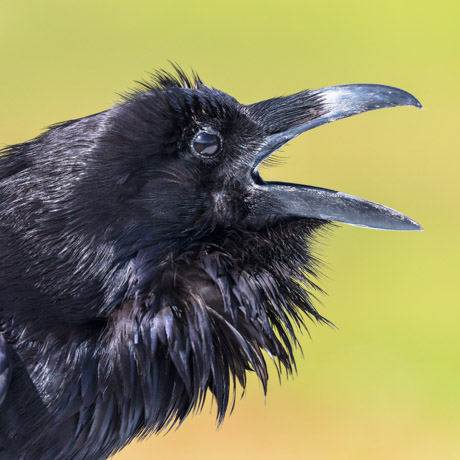Raven Rendezvous
July 1 - 4
Lamar Buffalo Ranch
No
Colleen Marzluff, M.S., John Marzluff, Ph.D.
18+
Field Seminars
You will be immersed in ongoing research into the raven's world during field tours, where you'll actively participate in the observation and tagging of ravens while engaging in discussions about our findings.
As scientists, we encourage you to approach the natural world with rigorous curiosity and enthusiastic wonder, and we aim to instill these perspectives in our students. In this class, you'll learn firsthand about raven language, ecology, evolution, and behavior, with a focus on how this engaging species coexists among wolves and people. The connection between ravens and wolves serves as a dramatic example of a scavenger-predator relationship, and you will experience this connection by observing the many raven pairs we have tagged, from Tower Junction to Cooke City, as they interact with the Junction Butte Wolf Pack at kill and den sites.
Currently, raven populations are expanding, and some managers propose lethal control to bolster declining populations of sage-grouse, shorebirds, and desert tortoises. You will confront this issue with an excursion to Gardiner that emphasizes a sustainable conservation approach: working with diverse stakeholders to reduce subsidies fueling raven population growth. In addition to field studies, you will engage in discussions about how ravens and wolves have inspired Yellowstone and the Pacific Northwest indigenous cultures, providing a contrast with today's relationship. Finally, you will explore past tribal injustices, such as why the Absaroka people were misnamed "Crow," and delve into current practices involving ravens, like the spring bison hunt, which is a major social event for both ravens and the Nez Perce and other NW tribes.
About the Instructor
John Marzluff is a professor of wildlife science at the University of Washington. Marzluff’s early research focused on the social behavior and ecology of Jays and ravens. His current interest is bringing a behavioral approach to pressing conservation issues, and blending biology, conservation, and anthropology to understand the co-evolution of human and animal cultures. Marzluff’s research has been featured in National Geographic, Audubon, Science, and Birding publications, and PBS Nature, NOVA, Bill Nye Saves the World, and Animal Planet. His recent books, Welcome to Subirdia, and In Search of Meadowlarks, suggest ways in which people can steward the splendid array of biological diversity in settled and agricultural lands.
Colleen Marzluff completed her bachelor’s degree at Whitman College in Walla Walla, Washington in 1982. She returned to her native southwest to study biology at Northern Arizona University, where she completed a master’s thesis on the feeding ecology of Abert’s squirrels. After completing her degree, she worked with Dr. Russell Balda as a technician in his Avian Cognition Lab. Today she is involved in several local organizations and to keep her animal behavior skills sharp, she participates in pet therapy, agility, and herding.
Testimonials
"Katy, Scott & the staff at Buffalo Ranch were fantastic! All the buildings were clean, organized & wonderful." - Christine, VA
"I always love the classes and learn alot every time" - Sheree, OR






